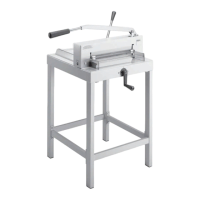
Do you have a question about the IDEAL 3905 and is the answer not in the manual?
Warning against children operating the machine.
Crucial warnings about the sharp blade and avoiding contact.
Prohibition of cutting hard or splintering materials.
Emphasizes that the machine is designed for single-person operation.
Prohibition of operating the machine without all safety devices installed.
Closing the front guard and releasing the blade lock.
Instructions for lowering the blade lever using both hands.
How to return the blade lever to its top position and engage the safety lock.
Role of the front guard and conditions for enabling the cutting function.
Warning against reaching under the blade when it is not locked.
Steps for unpacking and assembling the stand accessory.
Safely lifting and placing the machine onto the stand or workbench.
Warnings about potential injury and finger protection during lifting.
Fastening the machine to the stand using provided hardware.
Attaching operational levers and the backgauge crank.
Diagram and labels for machine components and controls in English.
Confirming understanding of instructions and proper function of safety devices.
Requirements for cover mounting and conditions for activating the cutting mechanism.
Procedures related to the front safety cover and its proper function.
Adjusting the backgauge crank to set the desired measurement.
Using the scale and calibration ring for accurate measurement settings.
Further details on using the graduated ring for precise measurement settings.
How to lock the measurement setting to avoid accidental adjustments.
Positioning the paper stack accurately against guides.
Final steps for positioning the paper stack before cutting.
Procedure for securing the paper stack with the clamp.
Actions to release the blade lock and lower the blade lever to initiate cutting.
Returning the blade lever and press lever to their original positions.
Lifting the front guard and removing the cut paper.
Steps to address issues with cutting quality, such as dull blades.
Information on blade height limits, sharpening, and replacement procedures.
Critical safety warnings for handling sharp blades and during replacement.
Detailed safety advice and procedures for blade replacement.
Safety instructions for handling and replacing the knife (blade).
Steps to gain access to the blade by removing the cover.
Procedures for releasing the blade and removing the machine cover.
Securing the blade lever and lifting the front guard before screw removal.
Removing the screws and washers that secure the blade.
Proper attachment and securing of the blade changing tool.
Taking out the remaining screws after attaching the tool.
Loosening grips and carefully removing the old blade.
Placing and securely fastening the new blade into the carrier.
How to remove the cutting stick from its slot using a screwdriver.
Procedures for rotating or replacing the cutting stick for continued use.
Safety precautions to be observed during cutting stick replacement.
Attaching the new blade to the blade changing tool.
Verifying correct spacing and ensuring the blade is covered.
Safety warnings related to handling the blade during preparation.
Adjusting screws and sliding the blade with the tool into the blade carrier.
Firmly securing the blade by tightening the grips.
Lightly tightening the first set of blade screws.
Detaching and removing the blade changing tool.
Lightly tightening the remaining blade screws to secure the blade.
Placing the blade onto the cutting stick using the blade lever.
Adjusting the screw to create a visible light gap between blade and stick.
Using adjustment screws to align the blade height with the cutting stick.
Conducting a test cut and adjusting blade depth if the cut is incomplete.
Warning about ensuring the blade is always covered by the clamping bar.
Emphasizing the importance of blade coverage by the press during trial cuts.
Securing the blade by tightening all screws after adjustments.
Sliding and securely fastening the protective cover.
Requirement for trained personnel to perform maintenance tasks.
Instructions for lubricating all moving parts with appropriate lubricants.
Procedure for cleaning machine parts before applying lubricant.
Ensuring the blade lever does not fall down automatically.
Tightening the hexagon screw to maintain lever stability.
Initial steps to identify why the machine is not functioning.
Procedures to follow when a cut cannot be initiated.
Solutions for when the last sheet of paper is not cut completely.
Recognizing issues like blunt blades causing poor cuts or increased effort.
Procedure for replacing the blade to resolve cutting quality problems.
Details for contacting customer service via website or email.
Part number for the recommended replacement blade.
Part number for the recommended cutting stick set.
Part number for the recommended blade changing tool.
Part number for the recommended stand accessory.
Information regarding safety approvals and quality certifications.
Location of technical data and notice about potential alterations.